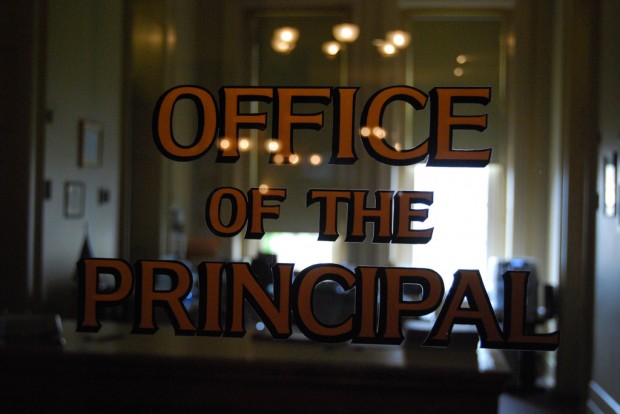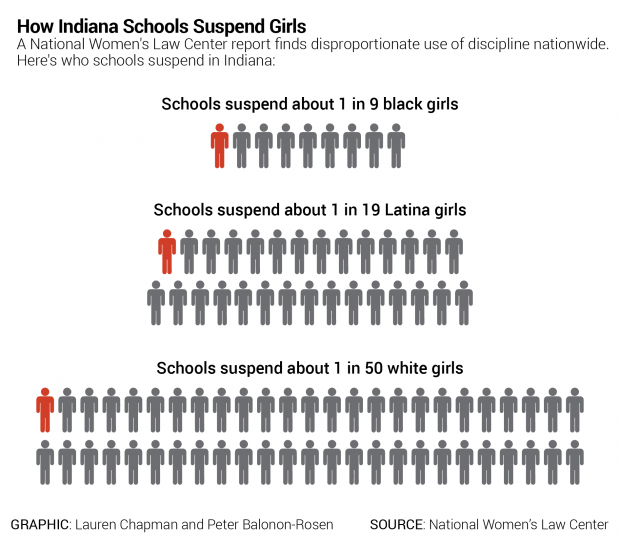Report: Girls Of Color Face Harsher Discipline In Indiana Schools

A new report highlights the disproportionate suspension of girls of color in Indiana schools. (Eric Castro/Flickr)” credit=”
Girls of color are much more likely than white girls to be suspended from Indiana schools and schools nationwide, according to a new report.
Indiana schools suspend about one in nine black girls, one in 29 Latina girls and one in 50 white girls, according to the report from the National Women’s Law Center.
“We should all be very alarmed,” says Jasmine Tucker, director of research at the National Women’s Law Center. “Discipline is a problem across the board and Indiana is up there with black girls, in particular, being especially likely — about six times as likely — to be suspended from school.”
The national report — which analyzed U.S. Department of Education Office of Civil Rights data from the 2013-14 school year — finds disproportionate use of discipline results in lost class time and increased school pushout.
Black girls in all states are more likely to face multiple suspensions. Students who are suspended are five times as likely to drop out of school and three times as likely to be involved with the juvenile justice system.
“This is a critical time when girls need to be supported and be told they can be anything they want to be,” Tucker says. “And these disproportionate discipline rates are pushing these girls out of school.”
As we’ve previously reported, students of color across race and gender face harsher discipline in Indiana schools — from suspension to corporal punishment. This report takes a fresh look at how girls, specifically, fare in school discipline.
Indiana Suspends More Girls, Has Wider Discipline Gaps Than Nation
Indiana’s 11.5 percent suspension rate for black girls is one of the highest in the nation. Only two states, Michigan and Illinois, have higher suspension rates for black girls. And Indiana also houses one of the widest gaps between rates of suspension for girls of color and white girls.
Schools are six times more likely to suspend black girls and 1.8 times more likely to suspend Latina girls, compared to their white peers.
The Indiana Department of Education declined an interview for this story. Instead, department spokesperson Adam Baker says in an email that it’s up to local districts to address the imbalance.
“It is important to us all children receive a quality education in an environment conducive to providing just that,” Baker says. “While local districts are responsible for creating discipline policies that best meets the needs of their communities, we are always available for both parents and schools who have concerns.”
Tucker, the researcher, says it’s important to acknowledge the specific challenge girls face in schools: two in three carry post-traumatic stress, one in five girls are sexually assaulted before age 18 and one in nine experience homelessness.
“These girls are carrying around a lot more trauma than anyone would have thought,”Tucker says. “Schools need to create environments where girls feel safe because they might not be getting that elsewhere.”
Bias, Conscious Or Unconscious, Plays Out In Schools
Nationwide, black girls are 5.5 times more likely to be suspended than white girls. And it’s often for non-violent offenses: defiance, violating dress codes, disrespect — situations that require a judgement call.
According to study after study after study, teachers’ behaviors — often directed by conscious or unconscious biases — affect students’ lives, from student discipline to promotion.
That’s important to acknowledge in Indiana, where 94 percent of educators are white, because implicit biases — unconscious bias that affect our outlook and behaviors — can play out for teachers and administrators.
“Such that when they see girls of color acting in a certain way they may perceive it as more problematic and in need of intervention,” says Daniel Losen, director of Center for Civil Rights Remedies at University of California, Los Angeles. Losen and the center study schools and disproportionate discipline practices.
And for girls of color — especially black girls — ingrained biases about race and gender could be a factor in the high suspension rates.
“There’s both gender bias and racial bias,” Losen says. “There are stereotypes specific to black girls – for example that they’re more masculine, that they’re louder. Things like that that are negative stereotypes that are really particular to black girls.”
Shedding Light
Another factor at play? Resources. Students of color nationwide are more likely to have inexperienced teachers.
“There are resource inequalities that affect children of color more so than other students,” Losen says. “If you’re in a school or district with resource shortfalls, those are the kinds of teachers that are more likely to lose control of their classroom or not be as effective in engaging students.”
And that, too, leads to suspension.
Still, researchers hope that reports zeroing in on girls of color’s experience with suspension can help lay out the data and influence policy to keep kids in school.
For instance, states that collect data on the reasons why schools suspend don’t collect numbers by race and gender. It’s generally one or the other.
“We either look at race altogether, or gender without looking at race,” Losen says. “There is that confluence of race and gender that is important.”
